Good health and youthfulness are something that all of us crave
for, particularly those dedicated to healthy living. While eternal youth
or youthfulness may be as evasive as the 'fountain of youth', healthy
living is very achievable. The listed ‘healthy foods’ below will not
only help you to stay young but will also help to decrease your risk
for some life threatening diseases like diabetes, cardiovascular disease
and cancer. Remember your body will be good to you only if you be good
to your body. So try and include not all, but as many as possible from
the listed healthy foods below in your daily diet.
| Cereals and Grains: | |
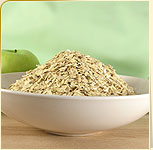 |
Oatmeal
Oatmeal is loaded with B complex
vitamins, calcium, iron as well as protein. It can be a perfect morning
fuel for weight watchers as it contains soluble fiber which offers many
health benefits, from lowering your cholesterol levels, to helping you
stay satiated for a long period of time. If you don’t prefer the taste
of oatmeal, try topping it with any seasonal fruits or dry fruits of
your choice. Unsweetened plain yogurt along with oatmeal can also be a
healthy but appetizing combination. |
 |
Brown Rice
Unlike its white polished
counterpart, brown rice is a rich source of magnesium, selenium,
manganese and fiber. Substitute white rice with nutritious brown rice
wherever and whenever possible in your diet. |
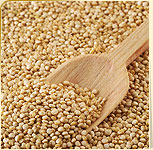 |
Quinoa
More than any other grains,
quinoa is packed with proteins along with riboflavin, iron and
magnesium. Rinse this cereal before eating to prevent the bitter taste. |
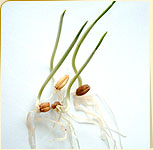 |
Wheat Germ
Magnesium from wheat germ will
help to prevent muscle cramps. Wheat germ is also a good source of
vitamin E. Sprinkle some over your cereals, yogurt and fruits to get the
nutrients from wheat germ. |
| Pulses and Legumes: | |
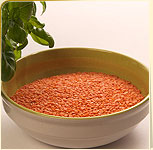 |
Lentils
The heart healthy fiber along
with isoflavones from lentils may have a protective effect against
breast cancer. Add lentils in any form dried, canned or already in soup
for a protein packed meal. |
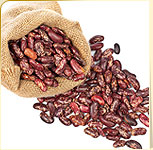 |
Pinto Beans
Folates from pinto beans have a
heart protective effect and also reduce any risk of birth defects in new
born infants. |
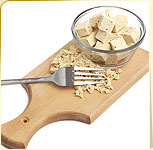 |
Tofu
A very good source of soy protein
and omega 3 fatty acids, tofu offers cardiovascular benefits by
lowering the low density lipoprotein cholesterol levels in the body. |
| Nuts and Oilseeds: | |
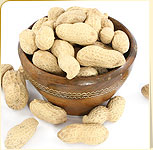 |
Peanuts
Polyunsaturated and
monounsaturated fatty acid from peanuts helps to decrease the risk of
cardiovascular diseases by a significant margin. Munch on these healthy
nuts when you feel hungry instead of binging on any fried snacks. |
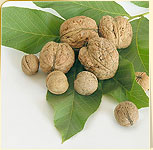 |
Walnuts
These brain shaped nuts not only
look like brain but its omega 3 fatty acids offer many protective
effects to brain. Omega-3 fatty acids along with manganese also have a
heart protective effect. |
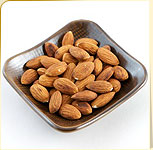 |
Almonds
Monounsaturated fats from almonds
may reduce your risk for heart disease and also lower your low density
lipoprotein cholesterol. In addition to healthy fats, almonds are also
packed with vitamin E, magnesium and potassium. |
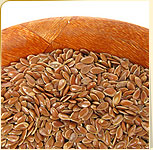 |
Flaxseeds
An excellent source of omega 3
fatty acids, flaxseeds have anti-inflammatory benefits and protect
against heart disease, diabetes, bone disease and cancer. |
| Fruits and Vegetables: | |
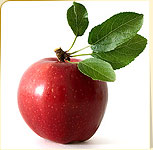 |
Apples
Cardio-protective fiber and
flavonoids from apples also prevent constipation. Drink a glass of fresh
apple juice to prevent the formation of kidney stones. |
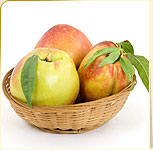 |
Apricots
Apricots are a rich source of
beta carotene which gets converted to vitamin A in the body. Both beta
carotene and vitamin A are potent antioxidants that help to scavenge the
free radicals from the body and have a protective effect against many
types of cancers and heart diseases. You may choose fresh and firm
apricots or may even snack on dried ones. |
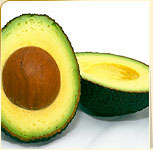 |
Avocadoes
Oleic acid from avocadoes helps
to lower the total cholesterol levels and even increase the high density
lipoprotein levels in the body. Moreover avocado also provides a good
dose of fiber. Try an avocado dip or guacamole in your burger instead of
other fat loaded dressings. |
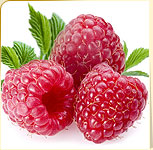 |
Raspberries
This dark berry can be a perfect
excuse to include whipped cream in your diet. Raspberries are packed
with vitamin C and fiber. The ellagic acid present in this tiny berry
may help to halt growth of cancerous cells. |
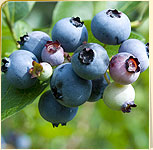 |
Blueberries
Blueberries are tangy nutritional
stars that are bursting with flavor and nutrition, at the same time low
in calories. They are a powerhouse of antioxidants including lutein, an
important component for vision. Choose fully ripe, but not overripe
blueberries to gain the maximum nutritional benefit. |
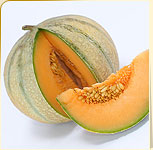 |
Cantaloupe
Cantaloupe, a popular variety of
melon is packed with two important antioxidants; vitamin C and vitamin
A. The pro-vitamin A in cantaloupe promotes your lung health, protects
your vision and vitamin C helps to fight against infection and boosts
your immune system. Eat fresh cantaloupe in winters or freeze cantaloupe
cubes and blend to make an icy smoothie in summers. |
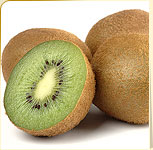 |
Kiwi Fruit
Vitamin C from kiwi protects the
body from any oxidative damage and phytonutrients from this fruit
protects the DNA. Peel just ripe kiwis and scoop the inner contents with
a spoon. |
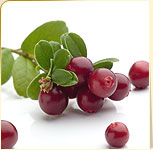 |
Cranberry
These bright red berries are rich
in vitamin C and dietary fiber. Cranberry juice is valued for its
ability to reduce risk of urinary tract infection. The hippuric acid
along with other components from the juice reduces E. coli adherence on
the walls of the urinary track, as a result of which it is flushed out
in the urine. |
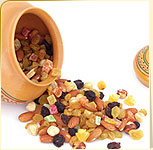 |
Raisins
Raisins are low in calories but
rich in iron and fiber. The phenols from these little gems have an
antioxidant property that helps to prevent oxygen based damage to the
body. Add some raisins in your morning breakfast cereal to get the
sweetness instead of adding sugar. |
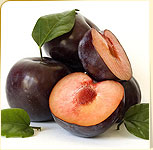 |
Plums
Phenols from plums offer a
significant antioxidant protection by neutralizing the destructive free
oxygen radicals that cause oxidative stress in the body. |
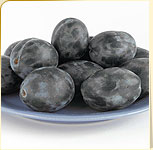 |
Prunes
Fiber from prunes offers
intestinal protection, improves bowel regularity and lowers cholesterol. |
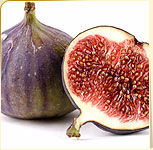 |
Figs
If you use the pill as a mode for
birth control then make sure to add some vitamin B6 in the form of
figs, as the pill depletes this vitamin from the body. Figs are also a
good source of fiber and potassium that can help you to lose weight and
maintain healthy blood pressure levels. Enjoy dried figs throughout the
year, but when in season don't forget to include sweet and ripe fresh
figs in your diet. |
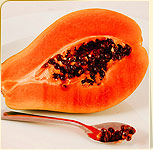 |
Papayas
Papaya is an excellent source of
vitamin C and also a good source of vitamin A, E and K. All these
antioxidants along with the fiber in papaya surely promote good health
and ward off a variety of diseases and conditions. |
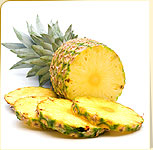 |
Pineapple
Bromelain from pineapple offers
potential anti-inflammatory and digestive benefits. Pineapple is also a
good source of manganese, ascorbic acid and thiamin which play a role in
antioxidant defenses and energy production. Fresh or canned pineapple
pieces with plain yogurt can be an excellent dessert option. |
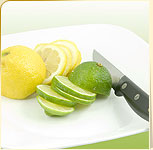 |
Limes and Lemons
Vitamin C from limes and lemons
along with furocoumarins and limonene help prevent many types of
cancers. Add a slice of lemon to your iron rich diet for better iron
absorption in the body. |
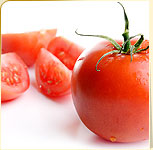 |
Tomatoes
Besides being rich in vitamin A
and vitamin C, tomatoes are an excellent source of lycopene. Lycopene, a
carotenoid acts as a potent antioxidant in the body and offers a
protective effect against several types of cancer and cardiovascular
diseases. Cook tomatoes in a dash of olive oil as lycopene is well
available in cooked form and in the presence of fat it is well absorbed
in the body. |
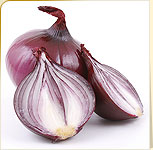 |
Onions
Onions are rich in flavanoids,
most notably quercitin as well as many phytonutrients and vitamin C. The
chromium from onions helps the body cells to respond well to the
hormone insulin. |
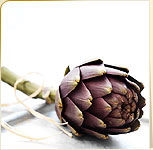 |
Artichokes
Silymarin, an antioxidant from
artichokes helps to prevent skin cancer and the fiber helps to control
cholesterol. |
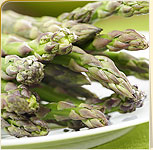 |
Asparagus
Asparagus is rich in folate, an
essential vitamin for cardiovascular system. Make asparagus a healthy
addition in your meal if you are planning to get pregnant as folate is
also a great birth defect fighter. |
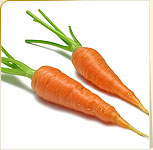 |
Carrots
As the richest vegetable source
of pro-vitamin A carotenoids, carrots offer protection against cancer
and cardiovascular diseases. Beta carotene from carrots helps to promote
good vision and also promote good lung health. |
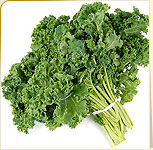 |
Kale
The organosulfur compounds in
kale help prevent cancer, especially ovarian cancer. Kale is also a rich
source of vitamin A, vitamin C and vitamin K which help to lower
cataract risk, promote lung health and boost immunity. |
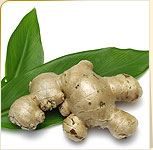 |
Ginger
Gingerols from ginger may help
reduce the queasiness. Other compounds in ginger may also help to ward
off arthritis and migraine pain by blocking inflammation-causing
prostaglandins. Try some fresh ginger ale to quench your thirst instead
of other sweetened and artificial drinks. |
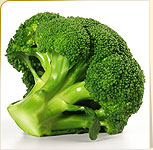 |
Broccoli
Packed with nutrients like
vitamin C, beta carotene, vitamin A and folate, broccoli can be an ideal
vegetable. Sulforaphane and indole-3-carbinol in broccoli may have a
protective effect against breast cancer. To preserve the phytonutrients
steam or lightly microwave the broccoli, avoid overcooking. |
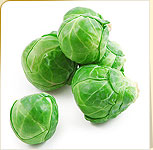 |
Brussels Sprouts
Sulforaphane, a potent plant
phytochemical present in Brussels sprouts have a protective effect
against various types of cancer including bladder cancer. Besides they
are also an exceptional source of vitamin K, vitamin C and fiber. Add
some of these sprouts to your cold salads if you don’t prefer them as
your main dish. |
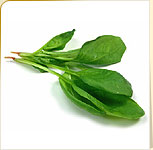 |
Spinach
Blessed with the healthiest
nutrients like calcium, iron, potassium, magnesium, beta carotene,
vitamin C, and vitamin B6, spinach can be considered a leafy powerhouse.
Include some blanched leaves in your soups, salads, omelets or lasagna
to get a power pack of nutrients. |
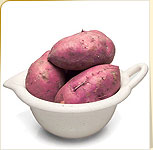 |
Sweet Potatoes
Unique root storage proteins in
sweet potatoes have been proved to have potent antioxidant effects.
Sweet potatoes are a sweet source of vitamin A, vitamin C, manganese,
copper and dietary fiber. |
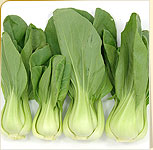 |
Bok Choy
This Chinese cabbage is rich in
brassinin, indoles and isothiocyanates all three may offer a protective
effect against breast cancer. Toss this vegetable lightly with a dash of
olive oil and minced garlic just before serving. |
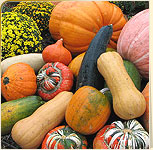 |
Winter and Summer Squash
A variety of health promoting
nutrients in both the squashes, like vitamin C, vitamin A, potassium,
magnesium and fiber promote overall health. |
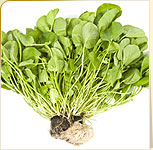 |
Arugula and Watercress
Vitamins C and vitamin E along
with phenethyl isothiocyanate and beta-carotene in both these greens
helps to keep cancer cells at bay. |
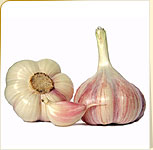 |
Garlic
The active components along with
the sulfur compounds in garlic gives a typical pungent flavor but also
helps to lower the low density lipoprotein cholesterol and also reduce
the risk of colon and stomach cancer. |
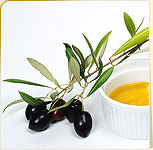 |
Olives
A concentrated source of vitamin E
and monounsaturated fatty acids, olives provide cellular protection
against free radicals support gastrointestinal health and prevent the
development of colon cancer. |
| Dairy Products and Eggs: | |
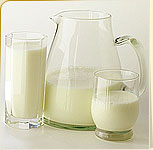 |
Skim Milk
Vitamin A along with riboflavin
in skimmed milk helps to maintain healthy vision and also reduces
allergies and eczema. The calcium and vitamin D from skim milk can not
be ignored. |
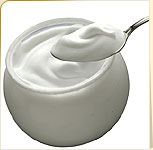 |
Yogurt
Calcium in active-culture yogurt
strengthens the bones and the bacteria help prevent yeast infections.
Mix some chopped fruits of your choice to make your yogurt sweet instead
of adding sugar. |
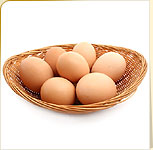 |
Eggs
Good quality proteins from eggs
along with choline boosts brain health. Choline in egg yolks also helps
reduce inflammation. Egg yolks are also a concentrated source of
cholesterol. |
| Seafood: | |
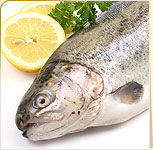 |
Fish
Fatty cold water fish like tuna,
mackerel and salmon are a rich source of omega 3 fatty acids. These good
fats are a blessing as they offer a protective effect against almost
everything; from lowering cholesterol, protecting the heart, fighting
inflammation to fighting many cancers and preventing Alzheimer's
disease. |
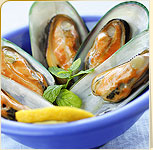 |
Clams and Mussels
Vitamin B12 from these shell
fishes helps to support brain and nerve function. They are also a good
source of iron, potassium and magnesium. |
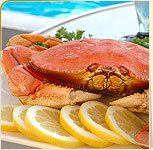 |
Crab
Zinc and vitamin B12 from crabs
will help boost your immunity. Try some crab curry or prepare your own
crab cakes at home. |
| Others: | |
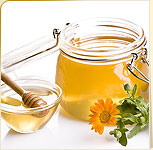 |
Honey
Raw honey, besides being sweet
golden nectar and a natural sweetener also has anti-viral, anti-fungal
and anti-bacterial properties. |
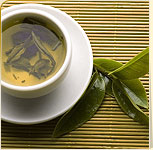 |
Green Tea
Health promoting flavonoids from
green tea are thought to have anticancer and antioxidant effects in the
body. |
 |
Water
Water is one of the healthiest
foods available on earth among the others. Although it has zero calories
and negligible nutrients it offers many health benefits which will help
you to remain healthy and young at heart. |
Follow this link....
51 Healthy Foods To Eat For Healthy Living: "- Sent using Google Toolbar"
Many thanks DietHealthClub.com!
















No comments:
Post a Comment